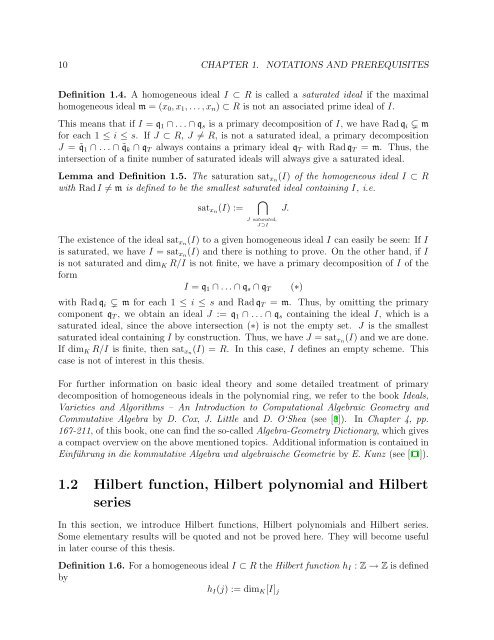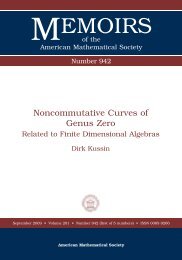University of Paderborn Department of Mathematics Diploma Thesis ...
University of Paderborn Department of Mathematics Diploma Thesis ...
University of Paderborn Department of Mathematics Diploma Thesis ...
You also want an ePaper? Increase the reach of your titles
YUMPU automatically turns print PDFs into web optimized ePapers that Google loves.
10 CHAPTER 1. NOTATIONS AND PREREQUISITESDefinition 1.4. A homogeneous ideal I ⊂ R is called a saturated ideal if the maximalhomogeneous ideal m = (x 0 , x 1 , . . . , x n ) ⊂ R is not an associated prime ideal <strong>of</strong> I.This means that if I = q 1 ∩ . . . ∩ q s is a primary decomposition <strong>of</strong> I, we have Rad q i mfor each 1 ≤ i ≤ s. If J ⊂ R, J ≠ R, is not a saturated ideal, a primary decompositionJ = ˜q 1 ∩ . . . ∩ ˜q k ∩ q T always contains a primary ideal q T with Rad q T = m. Thus, theintersection <strong>of</strong> a finite number <strong>of</strong> saturated ideals will always give a saturated ideal.Lemma and Definition 1.5. The saturation sat xn (I) <strong>of</strong> the homogeneous ideal I ⊂ Rwith Rad I ≠ m is defined to be the smallest saturated ideal containing I, i.e.sat xn (I) :=⋂J.J saturated,J⊃IThe existence <strong>of</strong> the ideal sat xn (I) to a given homogeneous ideal I can easily be seen: If Iis saturated, we have I = sat xn (I) and there is nothing to prove. On the other hand, if Iis not saturated and dim K R/I is not finite, we have a primary decomposition <strong>of</strong> I <strong>of</strong> theformI = q 1 ∩ . . . ∩ q s ∩ q T (∗)with Rad q i m for each 1 ≤ i ≤ s and Rad q T = m. Thus, by omitting the primarycomponent q T , we obtain an ideal J := q 1 ∩ . . . ∩ q s containing the ideal I, which is asaturated ideal, since the above intersection (∗) is not the empty set. J is the smallestsaturated ideal containing I by construction. Thus, we have J = sat xn (I) and we are done.If dim K R/I is finite, then sat xn (I) = R. In this case, I defines an empty scheme. Thiscase is not <strong>of</strong> interest in this thesis.For further information on basic ideal theory and some detailed treatment <strong>of</strong> primarydecomposition <strong>of</strong> homogeneous ideals in the polynomial ring, we refer to the book Ideals,Varieties and Algorithms – An Introduction to Computational Algebraic Geometry andCommutative Algebra by D. Cox, J. Little and D. O‘Shea (see [3]). In Chapter 4, pp.167-211, <strong>of</strong> this book, one can find the so-called Algebra-Geometry Dictionary, which givesa compact overview on the above mentioned topics. Additional information is contained inEinführung in die kommutative Algebra und algebraische Geometrie by E. Kunz (see [11]).1.2 Hilbert function, Hilbert polynomial and HilbertseriesIn this section, we introduce Hilbert functions, Hilbert polynomials and Hilbert series.Some elementary results will be quoted and not be proved here. They will become usefulin later course <strong>of</strong> this thesis.Definition 1.6. For a homogeneous ideal I ⊂ R the Hilbert function h I : Z → Z is definedbyh I (j) := dim K [I] j
















